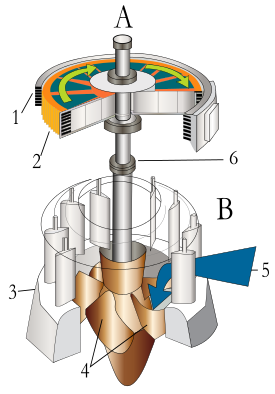|
Hydo-electric power stations boast a simple design and construction method that is very robust and reliable(when done properly). The following sub topic discusses the most important constituents of this kind of power station (as shown in figures 2 & 3).
Constituents of Hydro-electric power station
| Reservoir:
This is where water is stored for use as and when needed. The type and arrangement depends on topography of the site.
|
Penstock:
This is a conduit (conduits) that carry water to the turbines. They are made of reinforced concrete or steel. A surge tank is installed next to each penstock for over flow control and protection of penstock from bursting.
|
| Water turbine:
Water turbines are used to convert hydraulic energy of flowing water into rotational mechanical energy. Figure 3 is an example of the make of a typical water turbine.
|
Generator:
This machine is used to convert rotational mechanical energy transferred from the turbine through the shaft, into electrical energy. the produced electrical energy is transmitted to the transformer for long distance transmission.
|
Location of Hydro-electric power station: influencing factors
| Availablility of water:
Adequate water must be available at good head.
|
Cost and Type of Land:
Land should be available at reasonable price. The bearing capacity of the land should be enough to withstand huge structures & equipment.
|
| Storage of water:
A dam must be constructed to store water in order to deal with variations of water availability during the year.
|
Transportaion facilities:
The site should be accessible by rail and(or) road for ease in transporting equipment & machinery.
|
This schematic diagram must be properly understood. It is the basis upon which Hydro-electric power station designs are done. The individual power station complexity may differ slightly to the schematic and yet over and above that will use the same principle.
| 

